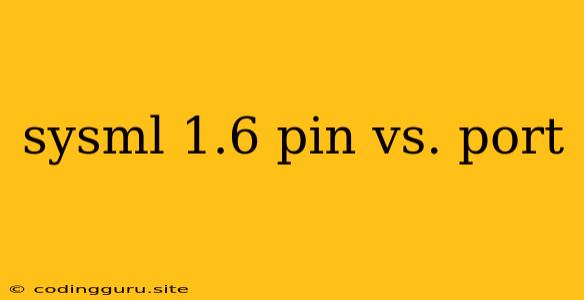Understanding the Difference Between Pins and Ports in SysML 1.6
System Modeling Language (SysML) is a powerful tool for modeling complex systems, especially in the context of embedded systems and software development. One of the key aspects of SysML is the ability to define interfaces and their interactions. Two fundamental concepts in this regard are pins and ports. While they may seem similar, understanding their distinct characteristics and usage is crucial for building accurate and robust system models.
What are Pins?
In SysML 1.6, pins are used to represent individual connections within a block. They are the building blocks of ports, defining specific signal or data flows. A pin can be thought of as a single wire or connection point on a block that can carry a specific type of data. For example, a pin might represent a voltage signal, a data bus, or a control signal.
Key characteristics of pins:
- Direction: Pins can be input, output, or inout, indicating the direction of data flow.
- Type: Each pin is assigned a specific data type, defining the nature of the data it carries.
- Multiplicity: Pins can be defined with a multiplicity, indicating the number of connections the pin represents (e.g., a single pin or an array of pins).
What are Ports?
Ports in SysML 1.6 are the aggregation of pins, representing a complete interface between blocks. They encapsulate a group of pins that work together to provide a specific service or functionality. A port can be thought of as a socket or connector on a block that exposes a set of pins to the outside world.
Key characteristics of ports:
- Role: Ports are assigned a role, which defines their purpose within the system (e.g., a sensor port, an actuator port, or a communication port).
- Protocol: Ports can define a protocol, specifying how data is exchanged between connected blocks.
- Flow specification: Ports can define the flow of data between connected blocks using flow properties.
The Relationship between Pins and Ports: An Example
Imagine a block representing a motor control system. This system might have:
- Pin 1: Input pin for speed commands (type: integer, direction: input)
- Pin 2: Output pin for motor position feedback (type: real, direction: output)
- Pin 3: Input pin for control signals (type: Boolean, direction: input)
These three pins can be grouped together to form a port called "Motor Interface." This port represents the complete interface for controlling the motor, including the necessary data flow and control signals.
Why Use Pins and Ports?
Using pins and ports offers several advantages in modeling:
- Modularization: Breaking down interfaces into smaller units (pins) allows for easier understanding and management of complex systems.
- Reusability: Ports can be reused in different parts of the model, promoting consistency and reducing redundancy.
- Hierarchical Modeling: The relationship between pins and ports allows for hierarchical modeling, where complex interfaces can be built from simpler ones.
- Improved Communication: Using clear definitions for ports and pins ensures better communication and collaboration among engineers involved in system development.
Tips for Effective Use of Pins and Ports:
- Define clear roles for ports: Ensure each port has a well-defined role in the system, making it easier to understand its purpose and functionality.
- Use appropriate pin types: Select the correct data type for each pin to accurately represent the information it carries.
- Specify flow properties: Define the flow of data between connected blocks through ports and pins using flow properties.
- Document connections: Clearly document the connections between ports and pins, including the specific pins involved and their roles.
Conclusion
Understanding the difference between pins and ports in SysML 1.6 is crucial for modeling complex systems effectively. Pins represent individual connections, while ports provide a complete interface by aggregating pins. By understanding the specific characteristics and usage of each, modelers can create more accurate, robust, and easily maintainable system representations. This leads to better collaboration, improved design decisions, and ultimately, more successful system development.
